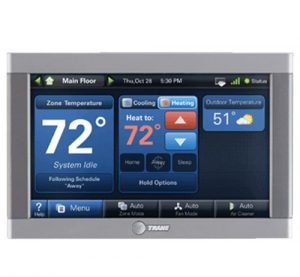Are you tired of cold floors during the winter? Maybe you’re looking for a more efficient way to heat your home.
If so, a radiant floor heating system may be the perfect solution for you.
There are many types of floor heating systems available today. Each is designed to meet a specific customer need.
Let’s take a closer look at how these systems work and touch on the different types available on the market.
How Radiant Floor Heating Works
Radiant in-floor heating systems operate by transferring heat directly from the hot surface to people or objects within the room.
An example would be feeling the warmth from a hot stove top element from across the room.
This process is known as radiant heat transfer, which is more efficient than other heating systems because it uses less energy and eliminates duct losses.
Since it doesn’t require air circulation like traditional forced air systems do, it is more suitable for allergy sufferers as it reduces allergens in the air.
Types of Radiant Floor Heating Systems
There are three main types of radiant floor heating:
- radiant air floors (air is used as the heat-carrying medium)
- electric radiant floors
- hydronic (hot water) radiant floors
Let’s take a closer look at each type:
Air-Heated Radiant Floor Heating System
A radiant air floor heating system is a forced-air heating system that utilizes heated air passing through ducts installed beneath the floor.
This type of underfloor heating system produces radiant heat that radiates upwards into the living space. The forced air warms the substrate, typically concrete, which acts as a conductor to disperse and radiate heat throughout the room.
It’s a floor heating solution that is a comfortable, energy-efficient, and cost-effective way to warm your home in all seasons.
Air-heated radiant floors are relatively inexpensive. However, they also have limited temperature control options due to their reliance on blowers and ducts for the distribution of warm air.
In other words, you might have trouble reaching your desired temperature in colder temperatures.
Electric Radiant Floor Heating System
Electric radiant heat is the perfect home heating solution for those looking to reduce their energy bills. This type of radiant heat system consists of heating cables installed under the concrete slab of your floor.
Although they require a considerable investment, they can help lower overall energy costs by taking advantage of time-of-use rates offered by electric utility companies.
With such a system, radiant heat is stored in the thermal mass of the thick concrete floor during off-peak hours.
Over an extended period, the heat stored within the floor rises into your living spaces. This way, you don’t have to rely on electricity or other energy sources to keep a room warm.
While electric radiant floors are easier and cheaper to install, they still have higher operating costs compared to hydronic heating systems.
Hydronic Radiant Floor Heating System
Hydronic radiant floor heating systems utilize heated water to provide radiant heat.
The warm water is delivered through tubing that is laid underneath the floors, allowing for evenly spread radiant heat.
This radiant heat brings both warmth and energy efficiency via the hydronic method.
Controlling and regulating hydronic systems are done with the aid of valves or pumps, a smart thermostat, and even zoning features.
Installing a radiant hydronic system may come with associated costs related to location, size of the home, type of installation, flooring materials, and other factors.
Nevertheless, one can expect improved efficiency and comfort added to their home.
Hydronic systems are typically more expensive to install. However, they also provide better temperature control than other options.
Types of Radiant Floor Heating Installations
Each type of radiant floor heating can be further categorized by installation methods such as wet installations (concrete poured over the tubing) or dry installations (subfloor panels).
Wet Installations
Wet radiant floor heating installations are one of the most popular radiant heat systems today. For many, they are the oldest form of modern radiant floor systems.
This radiant heating system requires cables or tubing to be installed directly in a thick concrete foundation slab or in a thin layer of concrete, gypsum, or other material that is placed over the subfloor.
It is important to consider the weight before deciding to install this type of radiant heating system as it can place considerable strain on the infrastructure.
Professional engineers should be consulted before embarking on such a project to determine if floor support is necessary to bear such weight.
Dry Installations
Dry radiant heating system installations involve warm air passing through a space beneath the floor, allowing heat to be transferred to this area.
This method has become increasingly popular due to its lower cost and speed of installation. Radiant heating systems like this require that the tubing or cables are suspended between the floor joists.
Reflective insulation must be designed to direct heat upwards and holes need to be drilled in order for the process to be completed.
Installing from above between two layers of subfloor is another available option for dry installations.
Pros and Cons of Radiant Floor Heating Systems
Radiant floor heating systems are an efficient and effective way of keeping warm floors in your home. Nevertheless, radiant systems do come with their fair share of advantages and disadvantages.
Here are a few of the pros and cons of radiant heating systems that homeowners should know:
Pro: More Energy Efficient
Radiant heating systems are taking the world of home heating by storm due to their energy-efficient and affordable features.
By not needing temperatures as high as traditional radiators (only 84 degrees Fahrenheit), energy is conserved when producing heat for the whole house.
Additionally, heated floors directly reduce the amount of energy wasted in comparison to air-based and duct-based systems. As a result, you can enjoy significant energy savings—up to 15% on heating bills.
Pro: Virtually Invisible Hardware
Radiant heating systems provide all the warmth of traditional HVAC, radiators, and space heaters with none of the eyesores.
Not only do radiant systems offer maximum comfort for home dwellers with increased energy efficiency, but they have the added bonus of being hidden from the view of guests.
If you’re concerned about the aesthetics of the heating systems you choose, radiant heating is a great option to consider.
Installers are trained to hide these systems under your floors without ever compromising the superior heating output you require.
Radiant heating systems come in both wet and electric varieties, providing customers with various innovative ways to heat their homes while enjoying a complete sense of discreteness.
Con: Hard to Access the Radiant System for Repairs
Radiant floor heating is becoming increasingly popular for its many benefits, including improved energy efficiency and health benefits. However, it does pose significant drawbacks when it comes to repairs and maintenance.
As radiant heating systems are installed beneath the floor, it requires serious effort in order to access the heating elements. This can lead to significantly higher labor costs for any repair or maintenance services.
Additionally, radiant floor systems are generally more expensive upfront and take longer to install than traditional forced air systems.
Con: Lag in Heat Movement
Radiant heat flooring can take up to two hours to deliver its full level of heat, due to the time lag of heat movement through the floor.
This can be a problem if there are other sources already at work heating a space, such as passive solar. Overheating could result from too much energy concentrated in one area.
To avoid any issues and ensure optimum comfort levels, it is best to disable or forgo radiant flooring when solar panels or other forms of forced air heating would suffice in the same location.
How Much Is Radiant Floor Heating Installation?
The cost of radiant floor installation may vary depending on the square footage of your home. However, the national average cost of installation across the US is around $3,800.
Costs usually range from $1,700 to $6,000, so you may find yourself on either end depending on the specifics of your project.
Lower-end costs can start around $200 and high-end prices are known to reach up to $10,000.
More Efficient Heating for Your Home
Radiant heating offers an efficient way to keep your home warm during the colder months while using less energy than traditional forced air systems.
As mentioned, they come in three main types—radiant air floors, electric radiant floors, and hydronic (hot water) radiant floors—which can be further categorized by installation method depending on your needs and budget.
With the many options available, finding the perfect system for your home should be easy. So if you’re looking for an effective way to keep your feet warm all winter long without breaking the bank, then consider investing in a radiant in-floor heating system today.
Looking for the Right Underfloor Heating Solution? We Got You Covered!
We value and prioritize the safety and comfort of our clients here at BelRed. If you’re having trouble deciding on which radiant heat system to choose for your home, we are more than happy to assist you!
Our technicians are skilled and knowledgeable about the different heating solutions available today. Whether you’re looking for ways to prevent heat loss or are on the hunt for a low-maintenance heating solution, we are confident that our experts can help you.
To make things convenient for everyone, we offer a variety of services that range from heat pump repair to furnace installation services. Learn more about it by reaching out to us today!
Call Us At (855) 345-6161
We look forward to working together!







